This conference followed on the First International RHIZOSPHERE
Conference, which took place in Munich (Germany) in 2004 and gathered
about 480 participants from worldwide to celebrate the centenary
of the rhizosphere concept. With RHIZOSPHERE 2, the challenge was
to gather an enlarged scientific audience, more open to developing
countries while maintaining the high scientific standard of RHIZOSPHERE
2004, in order to warrant the launching of this new series of international
conferences, at the interface between many disciplines. This was
successfully achieved as more than 570 participants from 48 countries
attended RHIZOSPHERE 2 from 26 to 31 August 2007 at Le Corum, Palais
des Congrès de Montpellier. Compared with Munich in 2004,
24 % of the participants were coming from Africa, Central and South
America and Asia (11% in Munich), partly as a result of the
policy to encourage students and younger scientists from developing
countries to attend, via grants which were awarded to 23 of them
(full coverage of travel, on site costs and registration fees).
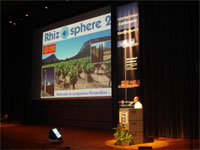 |
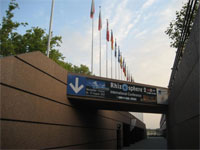 |
Distribution of participants per country
(with more than one
participant)
| France |
149 |
Sweden |
13 |
| Germany |
75 |
Switzerland |
11 |
| United Kingdom |
36 |
Finland |
10 |
| Italy |
32 |
Brazil / Denmark |
8 |
| Japan |
26 |
Algeria / Iran / Peop. Rep. China / Tunisia |
7 |
| Spain |
20 |
Belgium / Czech Rep. / USA |
6 |
| Mexico |
18 |
Cuba / Israel / Morroco / Russia / South Africa
|
5 |
| Australia |
17 |
Egypt / India / Senegal / Slovenia |
4 |
| Canada |
15 |
Korea |
3 |
| Austria / The Netherlands |
14 |
Estonia / New Zealand / Poland |
2 |
In total 576 abstracts were submitted distributing among the 17
thematic sessions amongst which the largest were the following (number
of abstracts in brackets) : Symbioses and plant growth promotion
(110), Functional and structural diversity (56 -bacteria + 26 -fungi
and fauna),  Rhizoremediation and soil pollution (65), Fate and management
of nutrients (59), Root growth and plant functional diversity (48),
Cutting edge approaches/methodologies (41), Biological control and
plant health management (35). Compared with RHIZOSPHERE 2004 in Munich
where biodiversity gathered about 150 abstracts, and other issues
such as plant growth promotion, root growth and development, plant
nutrition and pollution/bioremediation were rather small, the distribution
of abstracts has thus been fairly different, illustrating the dynamics
of the rhizosphere scientific community. Another big surprise was
the decreasing importance of rhizosphere « classics » such
as plant health and molecular communication. Finally, in spite of
the rather small number of abstracts, the physical interactions session
gathered a rather huge audience for a parallel session.
Rhizoremediation and soil pollution (65), Fate and management
of nutrients (59), Root growth and plant functional diversity (48),
Cutting edge approaches/methodologies (41), Biological control and
plant health management (35). Compared with RHIZOSPHERE 2004 in Munich
where biodiversity gathered about 150 abstracts, and other issues
such as plant growth promotion, root growth and development, plant
nutrition and pollution/bioremediation were rather small, the distribution
of abstracts has thus been fairly different, illustrating the dynamics
of the rhizosphere scientific community. Another big surprise was
the decreasing importance of rhizosphere « classics » such
as plant health and molecular communication. Finally, in spite of
the rather small number of abstracts, the physical interactions session
gathered a rather huge audience for a parallel session.
The format of the conference followed that of RHIZOSPHERE 2004,
the so-called ‘Toni’s Model’, walking in the footsteps
of Anton Hartmann, his dedication warranting the success of Munich
Conference. In total 19 invited conferences, including 12 plenary
lectures, were given, as well as 84 volunteered oral communications,
including 24 in plenary sessions. The selection pressure was rather
large as 250 authors had expressed the wish to present and oral communication.
The high standard of the talks was underlined by the many participants
and record audience in spite of the nice weather and terraces in
the vicinity of the venue. Besides the talks, about 330 posters were
presented during 3 separate poster sessions. Poster awards were offered
by three sponsors. The poster award recipients were the following :
volunteered oral communications,
including 24 in plenary sessions. The selection pressure was rather
large as 250 authors had expressed the wish to present and oral communication.
The high standard of the talks was underlined by the many participants
and record audience in spite of the nice weather and terraces in
the vicinity of the venue. Besides the talks, about 330 posters were
presented during 3 separate poster sessions. Poster awards were offered
by three sponsors. The poster award recipients were the following :
Poster awards
1st Poster Session – FEMS Microbiology Ecology
Best Poster Awards
> 1st Prize: Liesje De Schamphelaire (Ghent University)
From rice plant to power plant: microbial fuel cells
generate electricity from root exudates
> 2nd Prize: Dominic Standing (University of Aberdeen)
High throughput screening of the effects of changing
rhizosphere carbon flow on bacterial antibiotic production.
> 3rd Prize: Alessandra Salvioli (Università degli
Studi di Torino)
The interaction between the arbuscular mycorrhizal fungus Gigaspora
margarita and its endobacterium: a molecular analysis.
|
2nd Poster Session – New Phytologist Best
Poster Awards
> 1st Prize: Aurélie Cébron (LIMOS, Nancy)
Phytoremediation of PAH-contaminated soil influence
the global bacterial population and favoured PAH-degraders
> 2nd Prize: Katja Rosenberg (TU Darmstadt)
Soil amoeba rapidly change bacterial community composition
in the Arabidopsis rhizosphere
> 3rd Prize: Miwa Okamoto (NARC-Hokkaido, Sapporo)
Organic nitrogen uptake and metabolite profiling of
sorghum seedlings grown in sterile culture
|
3rd Poster Session – Springer Best Poster
Awards
> 1st Prize: Gunnar Henkes (Research Centre Jülich)
Pseudomonas fluorescens systemically represses the
negative effect of Fusarium graminearum infection on 11C
allocation in barley roots
> 2nd Prize: Stephane Saj (University of Helsinki)
Are root-induced decomposer growth and plant N supply
positively associated amongst grassland plants?
> 3rd Prize: Robert Koller (UMR INPL-INRA Nancy)
Protozoa increase N uptake of mycorrhizal plants via
extra radical mycelium
|
Beyond its scientific success, RHIZOSPHERE 2 was also marked by
several highlights of its social programme :
 The
Welcome Cocktail in the Hall of Le Corum on Sunday 26 August in the
evening, proudly sponsored by Roullier Group, was entertained
by Amaïsoul jazz band and was a display of some of the most
innovative French cuisine, thanks to the creativity of Germain Traiteur,
Montpellier.
The
Welcome Cocktail in the Hall of Le Corum on Sunday 26 August in the
evening, proudly sponsored by Roullier Group, was entertained
by Amaïsoul jazz band and was a display of some of the most
innovative French cuisine, thanks to the creativity of Germain Traiteur,
Montpellier.
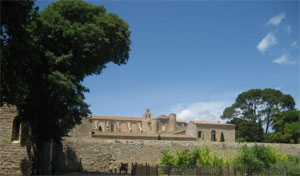
The Gala Dinner on Thursday 30 August was organised in a magic and
unique venue, the Valmagne Abbey at Villeveyrac (Hérault).
For this special occasion, the so-called « Cathédrale
des Vignes » which means « Cathedral of the
Vineyards », its magnificent cloister and church enclosing
enormous wine barrels was beautifully set by the Chef Germain Traiteur,
who managed again to astonish the senses of the 520+ participants.
This unique evening was punctuated by beautiful pieces of classical
music played by the « Quintette de Cuivre (Brass) de l’Orchestre
National de Montpellier », adding a final touch of class to
this Gala Dinner.
 A more limited number of delegates (about 150 in total) also attended
one of the 6 field scientific excursions organised around Montpellier
on Wednesday 29 August afternoon. This was a unique opportunity to
visit experimental sites linked with the issues addressed at the
Conference, as well as highlights of the local culture and the unique
landscapes of the Languedoc region, its fine wines and cuisine.
A more limited number of delegates (about 150 in total) also attended
one of the 6 field scientific excursions organised around Montpellier
on Wednesday 29 August afternoon. This was a unique opportunity to
visit experimental sites linked with the issues addressed at the
Conference, as well as highlights of the local culture and the unique
landscapes of the Languedoc region, its fine wines and cuisine.
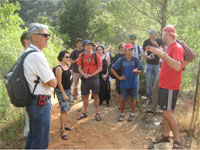
The organisation of RHIZOSPHERE 2 was based on an efficient International
Steering Committte chaired by Davey Jones (Univ. Bangor, Wales) and
composed of 14 well-recognized European scientists and on a dedicated
local organising committee which mobilised numerous French research
and higher education institutions beside INRA : CIRAD, CNRS,
IRD, SupAgro Montpellier and Université Montpellier 2, with
the commitment of several labs of the large Montpellier campus :
UMR BSR, B&PMP, CEFE, LSTM and UR SeqBio. The local organising
committee was chaired by Philippe Hinsinger (INRA-SupAgro UMR Biogéochimie
du Sol et de la Rhizosphère), while Sophie Pirkin was in charge
of the administrative coordination.
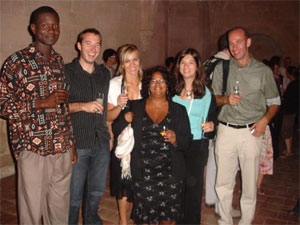
Professor Hans Lambers (University of Western Australia), Editor
in Chef of the journal Plant and Soil and Chair of the organising
committee of the forthcoming Conference in this new series,  RHIZOSPHERE
3 to be held in September 2011 at Perth, Australia, stressed as follows
the succes of this scientific event in Montpellier : « I
am writing to congratulate you with a fantastic meeting. It
was clearly one of the best I have ever attended. Of course
there were the usual problems wanting to attend competing talks,
but that is no reflecting on the organisers - it is simply inevitable. Well
done! I do hope people will have forgotten what a great job
you and your team have done four years down the track. »
RHIZOSPHERE
3 to be held in September 2011 at Perth, Australia, stressed as follows
the succes of this scientific event in Montpellier : « I
am writing to congratulate you with a fantastic meeting. It
was clearly one of the best I have ever attended. Of course
there were the usual problems wanting to attend competing talks,
but that is no reflecting on the organisers - it is simply inevitable. Well
done! I do hope people will have forgotten what a great job
you and your team have done four years down the track. »
Three special issues of international, refereed journals are currently
prepared, which will ultimately gather a selection of papers presented
at RHIZOSPHERE 2 :
FEMS Microbiology Ecology, Plant and Soil et Soil Biology and Biochemistry.








 Rhizoremediation and soil pollution (65), Fate and management
of nutrients (59), Root growth and plant functional diversity (48),
Cutting edge approaches/methodologies (41), Biological control and
plant health management (35). Compared with RHIZOSPHERE 2004 in Munich
where biodiversity gathered about 150 abstracts, and other issues
such as plant growth promotion, root growth and development, plant
nutrition and pollution/bioremediation were rather small, the distribution
of abstracts has thus been fairly different, illustrating the dynamics
of the rhizosphere scientific community. Another big surprise was
the decreasing importance of rhizosphere « classics » such
as plant health and molecular communication. Finally, in spite of
the rather small number of abstracts, the physical interactions session
gathered a rather huge audience for a parallel session.
Rhizoremediation and soil pollution (65), Fate and management
of nutrients (59), Root growth and plant functional diversity (48),
Cutting edge approaches/methodologies (41), Biological control and
plant health management (35). Compared with RHIZOSPHERE 2004 in Munich
where biodiversity gathered about 150 abstracts, and other issues
such as plant growth promotion, root growth and development, plant
nutrition and pollution/bioremediation were rather small, the distribution
of abstracts has thus been fairly different, illustrating the dynamics
of the rhizosphere scientific community. Another big surprise was
the decreasing importance of rhizosphere « classics » such
as plant health and molecular communication. Finally, in spite of
the rather small number of abstracts, the physical interactions session
gathered a rather huge audience for a parallel session.  volunteered oral communications,
including 24 in plenary sessions. The selection pressure was rather
large as 250 authors had expressed the wish to present and oral communication.
The high standard of the talks was underlined by the many participants
and record audience in spite of the nice weather and terraces in
the vicinity of the venue. Besides the talks, about 330 posters were
presented during 3 separate poster sessions. Poster awards were offered
by three sponsors. The poster award recipients were the following :
volunteered oral communications,
including 24 in plenary sessions. The selection pressure was rather
large as 250 authors had expressed the wish to present and oral communication.
The high standard of the talks was underlined by the many participants
and record audience in spite of the nice weather and terraces in
the vicinity of the venue. Besides the talks, about 330 posters were
presented during 3 separate poster sessions. Poster awards were offered
by three sponsors. The poster award recipients were the following : The
Welcome Cocktail in the Hall of Le Corum on Sunday 26 August in the
evening, proudly sponsored by Roullier Group, was entertained
by Amaïsoul jazz band and was a display of some of the most
innovative French cuisine, thanks to the creativity of Germain Traiteur,
Montpellier.
The
Welcome Cocktail in the Hall of Le Corum on Sunday 26 August in the
evening, proudly sponsored by Roullier Group, was entertained
by Amaïsoul jazz band and was a display of some of the most
innovative French cuisine, thanks to the creativity of Germain Traiteur,
Montpellier.
 A more limited number of delegates (about 150 in total) also attended
one of the 6 field scientific excursions organised around Montpellier
on Wednesday 29 August afternoon. This was a unique opportunity to
visit experimental sites linked with the issues addressed at the
Conference, as well as highlights of the local culture and the unique
landscapes of the Languedoc region, its fine wines and cuisine.
A more limited number of delegates (about 150 in total) also attended
one of the 6 field scientific excursions organised around Montpellier
on Wednesday 29 August afternoon. This was a unique opportunity to
visit experimental sites linked with the issues addressed at the
Conference, as well as highlights of the local culture and the unique
landscapes of the Languedoc region, its fine wines and cuisine.

 RHIZOSPHERE
3 to be held in September 2011 at Perth, Australia, stressed as follows
the succes of this scientific event in Montpellier : « I
am writing to congratulate you with a fantastic meeting. It
was clearly one of the best I have ever attended. Of course
there were the usual problems wanting to attend competing talks,
but that is no reflecting on the organisers - it is simply inevitable. Well
done! I do hope people will have forgotten what a great job
you and your team have done four years down the track. »
RHIZOSPHERE
3 to be held in September 2011 at Perth, Australia, stressed as follows
the succes of this scientific event in Montpellier : « I
am writing to congratulate you with a fantastic meeting. It
was clearly one of the best I have ever attended. Of course
there were the usual problems wanting to attend competing talks,
but that is no reflecting on the organisers - it is simply inevitable. Well
done! I do hope people will have forgotten what a great job
you and your team have done four years down the track. »